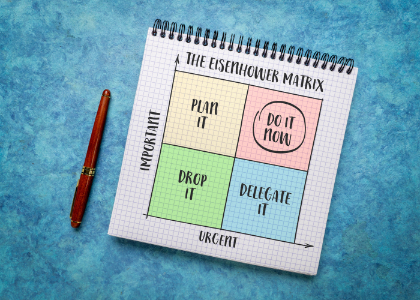
It’s easy to feel overwhelmed by the sheer number of tasks vying for our attention. How do we decide how to prioritize our tasks? How can we ensure that we’re not just busy but truly productive? Enter the Eisenhower Matrix, a time-tested tool that helps us prioritize tasks based on their urgency and importance. An excellent tool to distinguish between what’s important and what’s urgent is the Eisenhower Matrix.
What is the Eisenhower Matrix?
The Eisenhower Matrix, also known as the Urgent-Important Matrix, is a simple yet powerful tool for time management. It was popularized by President Dwight D. Eisenhower, who famously said, “What is important is seldom urgent, and what is urgent is seldom important.” This matrix helps us categorize our tasks into four quadrants:
- Quadrant 1: Urgent and Important
- Quadrant 2: Not Urgent but Important
- Quadrant 3: Urgent but Not Important
- Quadrant 4: Not Urgent and Not Important
Each quadrant guides us on how to approach the tasks within it.
Understanding the Quadrants
- Quadrant 1: Urgent and Important
- Tasks: These are crises, pressing problems, and deadlines that demand immediate attention.
- Action: Do it now. These tasks are both time-sensitive and crucial to your goals, so they should be handled as soon as possible.
- Example: A looming project deadline or an unexpected crisis at work.
- Quadrant 2: Not Urgent but Important
- Tasks: These are tasks that contribute to your long-term goals and personal growth but don’t require immediate action.
- Action: Schedule it. These tasks should be planned and allocated time in your calendar to ensure they’re completed.
- Example: Planning your career development, building relationships, or investing time in personal health and education.
- Quadrant 3: Urgent but Not Important
- Tasks: These are often distractions that seem urgent but don’t significantly contribute to your goals.
- Action: Delegate it. If possible, assign these tasks to others so you can focus on more important activities.
- Example: Interruptions like phone calls, meetings, or requests from others that don’t align with your priorities.
- Quadrant 4: Not Urgent and Not Important
- Tasks: These are activities that are neither time-sensitive nor crucial to your objectives. They often include time-wasters.
- Action: Eliminate it. These tasks should be minimized or removed from your schedule altogether.
- Example: Excessive social media browsing, trivial chores, or watching TV shows that don’t add value to your life.
How to Use the Eisenhower Matrix
- List Your Tasks: Start by writing down all the tasks you need to accomplish. Don’t worry about their order; just get everything out of your head and onto paper (or a digital tool).
- Categorize Each Task: Determine which quadrant each task belongs to. Ask yourself:
- Is this task urgent?
- Is this task important?
- Be honest about the value and impact of each task.
- Prioritize: Focus on Quadrant 1 tasks first since they require immediate attention. Next, allocate time for Quadrant 2 tasks, which will help you achieve long-term success. Delegate Quadrant 3 tasks if possible, and try to eliminate or minimize Quadrant 4 activities.
- Review and Adjust: Regularly review your Eisenhower Matrix to ensure you’re on track. As new tasks come in, assess where they fit in the matrix and adjust your schedule accordingly.
Tips for Differentiating Between Important and Urgent Tasks
- Importance: This relates to tasks that contribute to your long-term goals, values, and mission. Ask yourself, “Will completing this task move me closer to my key objectives?”
- Urgency: This involves tasks that require immediate attention, often due to external deadlines or pressure. Ask yourself, “Does this task need to be done now, or can it wait?”
Remember, the goal is to spend more time in Quadrant 2, where you focus on important but not urgent activities. This is where you can be proactive, plan ahead, and invest in tasks that truly matter for your future.
The Eisenhower Matrix is a practical tool for anyone looking to manage their time more effectively. By clearly distinguishing between urgent and important tasks, you can focus on what truly matters, reduce stress, and increase your productivity. Start using the Eisenhower Matrix today, and take control of your time and your life.
See how a Modern Observer Group coach can help you prioritize your tasks. Schedule a call here or contact us at the information below. Modern Observer Group programs are based on the Businetiks system as detailed in the book, “The Businetiks Way.”

